List of communities in Alberta
The province of Alberta, Canada, is divided into 10 different types of local governments – urban municipalities (including cities, towns, villages and summer villages), specialized municipalities, rural municipalities (including municipal districts/counties, improvement districts and special areas), Métis settlements, and Indian reserves. All types of municipalities are governed by local residents and were incorporated under various provincial acts, with the exception of improvement districts (governed by either the provincial or federal government), and Indian reserves (governed by local First Nations people under federal jurisdiction).

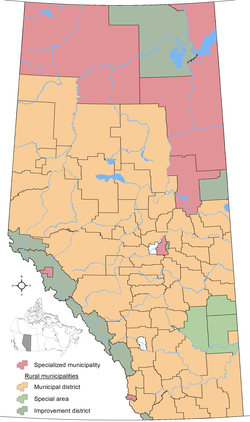
Alberta also has numerous unincorporated communities (including urban service areas, hamlets and a townsite) that are not independent municipalities in their own right. However, they are all recognized as sub-municipal entities by Alberta Municipal Affairs under the jurisdiction of specialized municipalities or rural municipalities, with the exception of the lone townsite (its jurisdiction is shared with an Indian reserve that surrounds it).
With the exception of Métis settlements, Statistics Canada recognizes all of Alberta's municipalities as census subdivisions and groups them into 19 census divisions based on geography. Within census divisions, Statistics Canada groups some of Alberta's municipalities/census subdivisions into two census metropolitan areas (CMAs) or 12 census agglomerations (CAs) for enumeration purposes. All CMAs include large urban centres and surrounding census subdivisions. All CAs also include large urban centres and in some cases their surrounding census subdivisions.
With the exception of Indian reserves, the administration of municipalities in Alberta is regulated by the Municipal Government Act,[1] the Special Areas Act[2] and the Metis Settlements Act.[3]
As of 2012, the combined unofficial population of all of Alberta's municipalities was 3,768,284.[4]
Municipalities
Urban municipalities
Cities
According to Section 82 of the Municipal Government Act (MGA), an area may incorporate as a city if:
- it has a population of 10,000 people or more; and
- the majority of its buildings are on parcels of land smaller than 1,850 m2.[1]
Essentially, cities are formed from urban communities with populations of at least 10,000 people.[5]
Alberta currently has a total of 19 cities with a combined population totalling 2,501,817 as of 2012.[4]
| Cities of Alberta | |||||||
|---|---|---|---|---|---|---|---|
| Name | Incorporation date (city)[6] |
Population (2016)[7] |
Population (2011)[7] |
Change (%)[7] |
Land area (km²)[7] |
Population density (per km²)[7] | |
| Airdrie | January 1, 1985 | 61,581 | 43,271 | +42.3% | 84.57 | 728.2/km2 | |
| Beaumont[AB 1] | January 1, 2019 | 17,396 | 13,284 | +31.0% | 10.47 | 1,661.5/km2 | |
| Brooks | September 1, 2005 | 14,451 | 13,676 | +5.7% | 18.59 | 777.4/km2 | |
| Calgary[AB 2] | January 1, 1894 | 1,239,220 | 1,096,833 | +13.0% | 825.56 | 1,501.1/km2 | |
| Camrose | January 1, 1955 | 18,742 | 17,286 | +8.4% | 42.62 | 439.7/km2 | |
| Chestermere[AB 3] | January 1, 2015[8] | 19,887 | 14,824 | +34.2% | 32.94 | 603.7/km2 | |
| Cold Lake | October 1, 2000 | 14,961 | 13,839 | +8.1% | 59.92 | 249.7/km2 | |
| Edmonton[AB 4] | October 8, 1904 | 932,546 | 812,201 | +14.8% | 685.25 | 1,360.9/km2 | |
| Fort Saskatchewan | July 1, 1985 | 24,149 | 19,051 | +26.8% | 48.18 | 501.2/km2 | |
| Grande Prairie | January 1, 1958 | 63,166 | 55,655 | +13.5% | 132.73 | 475.9/km2 | |
| Lacombe | September 5, 2010 | 13,057 | 11,707 | +11.5% | 20.81 | 627.4/km2 | |
| Leduc | September 1, 1983 | 29,993 | 24,304 | +23.4% | 42.44 | 706.7/km2 | |
| Lethbridge | May 9, 1906 | 92,729 | 83,517 | +11.0% | 122.09 | 759.5/km2 | |
| Lloydminster (part)[AB 5] | January 1, 1958 | 19,645[AB 6] | 18,032[AB 7] | +8.9% | 24.04 | 817.2/km2[AB 8] | |
| Medicine Hat | May 9, 1906 | 63,260 | 60,005 | +5.4% | 112.04 | 564.6/km2 | |
| Red Deer | March 25, 1913 | 100,418 | 90,564 | +10.9% | 104.73 | 958.8/km2 | |
| Spruce Grove | March 1, 1986 | 34,066 | 26,171 | +30.2% | 32.2 | 1,058.0/km2 | |
| St. Albert | January 1, 1977 | 65,589 | 61,466 | +6.7% | 48.45 | 1,353.7/km2 | |
| Wetaskiwin[AB 9] | May 9, 1906 | 12,655 | 12,525 | +1.0% | 18.31 | 691.2/km2 | |
| Total cities | — | 2,837,511 | 2,488,211 | +14.0% | 2,465.94 | 1,150.7/km2 | |
Towns
According to Section 81 of the Municipal Government Act (MGA), an area may incorporate as a town if:
- it has a population of 1,000 people or more; and
- the majority of its buildings are on parcels of land smaller than 1,850 m2.[1]
Essentially, towns are formed from urban communities with populations of at least 1,000 people. When a town's population exceeds 10,000 people, its council may apply to change its status to that of a city, but the change in incorporated status is not mandatory.[5]
Communities with shrinking populations are allowed to retain town status even if the number of residents falls below the 1,000 limit. Some of Alberta's towns have never reached a population of 1,000 people, but were incorporated as towns before the current requirement to have a population of 1,000 or more.
Alberta currently has a total of 108 towns, with a combined population totalling 458,376 as of 2012.[4]
| Towns of Alberta | |||||||
|---|---|---|---|---|---|---|---|
| Name | Specialized/rural municipality[9] |
Incorporation date (town)[10] |
Population (2016)[7] |
Population (2011)[7] |
Change (%)[7] |
Land area (km²)[7] |
Population density (per km²)[7] |
| Athabasca[N 1] | Athabasca County | September 19, 1911 | 2,965 | 2,990 | −0.8% | 17.65 | 168.0/km2 |
| Banff | Improvement District No. 9 (Banff) | January 1, 1990 | 7,851 | 7,584 | +3.5% | 4.77 | 1,645.9/km2 |
| Barrhead | Barrhead No. 11, County of | November 26, 1946 | 4,579 | 4,432 | +3.3% | 8.17 | 560.5/km2 |
| Bashaw | Camrose County | May 1, 1964 | 830 | 873 | −4.9% | 2.99 | 277.6/km2 |
| Bassano | Newell, County of | January 16, 1911 | 1,206 | 1,282 | −5.9% | 5.22 | 231.0/km2 |
| Beaverlodge | Grande Prairie No. 1, County of | January 24, 1956 | 2,465 | 2,365 | +4.2% | 5.73 | 430.2/km2 |
| Bentley | Lacombe County | January 1, 2001 | 1,078 | 1,073 | +0.5% | 2.24 | 481.3/km2 |
| Black Diamond | Foothills No. 31, M.D. of | January 1, 1956 | 2,700 | 2,373 | +13.8% | 3.84 | 703.1/km2 |
| Blackfalds | Lacombe County | April 1, 1980 | 9,328 | 6,300 | +48.1% | 16.44 | 567.4/km2 |
| Bon Accord | Sturgeon County | November 20, 1979 | 1,529 | 1,488 | +2.8% | 2.13 | 717.8/km2 |
| Bonnyville | Bonnyville No. 87, M.D. of | February 3, 1948 | 5,975[11] | 6,216 | −3.9% | 14.18 | 421.4/km2 |
| Bow Island | Forty Mile No. 8, County of | February 1, 1912 | 1,983 | 2,025 | −2.1% | 5.81 | 341.3/km2 |
| Bowden | Red Deer County | September 1, 1981 | 1,240 | 1,241 | −0.1% | 2.8 | 442.9/km2 |
| Bruderheim | Lamont County | September 17, 1980 | 1,308 | 1,155 | +13.2% | 7.12 | 183.7/km2 |
| Calmar | Leduc County | January 19, 1954 | 2,228 | 1,970 | +13.1% | 4.68 | 476.1/km2 |
| Canmore | Bighorn No. 8, M.D. of Kananaskis Improvement District[12] | June 1, 1966 | 13,992 | 12,288 | +13.9% | 69.43 | 201.5/km2 |
| Cardston | Cardston County | July 2, 1901 | 3,585 | 3,580 | +0.1% | 8.59 | 417.3/km2 |
| Carstairs | Mountain View County | September 1, 1966 | 4,077 | 3,442 | +18.4% | 11.92 | 342.0/km2 |
| Castor | Paintearth No. 18, County of | June 27, 1910 | 929 | 932 | −0.3% | 2.63 | 353.2/km2 |
| Claresholm | Willow Creek No. 26, M.D. of | August 31, 1905 | 3,780 | 3,758 | +0.6% | 8.11 | 466.1/km2 |
| Coaldale | Lethbridge County | January 7, 1952 | 8,215 | 7,493 | +9.6% | 7.99 | 1,028.2/km2 |
| Coalhurst | Lethbridge County | June 1, 1995 | 2,668 | 1,978 | +34.9% | 3.11 | 857.9/km2 |
| Cochrane | Rocky View County | February 15, 1971 | 25,853 | 17,580 | +47.1% | 29.83 | 866.7/km2 |
| Coronation | Paintearth No. 18, County of | April 29, 1912 | 940 | 947 | −0.7% | 3.62 | 259.7/km2 |
| Crossfield | Rocky View County | August 1, 1980 | 2,983 | 2,853 | +4.6% | 11.96 | 249.4/km2 |
| Daysland | Flagstaff County | April 2, 1907 | 824 | 807 | +2.1% | 1.75 | 470.9/km2 |
| Devon | Leduc County | February 24, 1950 | 6,578 | 6,515 | +1.0% | 14.3 | 460.0/km2 |
| Didsbury | Mountain View County | September 27, 1906 | 5,268 | 4,957 | +6.3% | 16.37 | 321.8/km2 |
| Drayton Valley | Brazeau County | February 1, 1957 | 7,235 | 7,118 | +1.6% | 30.72 | 235.5/km2 |
| Drumheller[N 2] | Kneehill County Special Area No. 2 Starland County Wheatland County[13] | March 2, 1916 January 1, 1998 | 7,982 | 8,029 | −0.6% | 108.03 | 73.9/km2 |
| Eckville | Lacombe County | July 1, 1966 | 1,125 | 1,125 | 0.0% | 1.6 | 703.1/km2 |
| Edson | Yellowhead County | September 21, 1911 | 8,414 | 8,475 | −0.7% | 29.72 | 283.1/km2 |
| Elk Point | St. Paul No. 19, County of | January 1, 1962 | 1,452 | 1,412 | +2.8% | 4.91 | 295.7/km2 |
| Fairview | Fairview No. 136, M.D. of | April 25, 1949 | 2,998 | 3,162 | −5.2% | 11.36 | 263.9/km2 |
| Falher | Smoky River No. 130, M.D. of | January 1, 1955 | 1,047 | 1,075 | −2.6% | 2.78 | 376.6/km2 |
| Fort Macleod[N 3] | Willow Creek No. 26, M.D. of | March 29, 1912 | 2,967 | 3,117 | −4.8% | 23.41 | 126.7/km2 |
| Fox Creek | Greenview No. 16, M.D. of | September 1, 1983 | 1,971 | 1,969 | +0.1% | 12.36 | 159.5/km2 |
| Gibbons | Sturgeon County | April 1, 1977 | 3,159 | 3,030 | +4.3% | 7.5 | 421.2/km2 |
| Grimshaw | Peace No. 135, M.D. of | February 2, 1953 | 2,718 | 2,515 | +8.1% | 7.09 | 383.4/km2 |
| Hanna | Special Area No. 2 | April 14, 1914 | 2,559 | 2,673 | −4.3% | 8.81 | 290.5/km2 |
| Hardisty | Flagstaff County | November 9, 1910 | 554 | 639 | −13.3% | 5.13 | 108.0/km2 |
| High Level | Mackenzie County | September 1, 1983 | 3,159 | 3,641 | −13.2% | 29.2 | 108.2/km2 |
| High Prairie | Big Lakes County | January 10, 1950 | 2,564 | 2,600 | −1.4% | 7.22 | 355.1/km2 |
| High River | Foothills No. 31, M.D. of | February 12, 1906 | 13,584 | 12,930 | +5.1% | 21.39 | 635.1/km2 |
| Hinton | Yellowhead County | December 29, 1958 | 9,882 | 9,640 | +2.5% | 33.52 | 294.8/km2 |
| Innisfail | Red Deer County | November 20, 1903 | 7,847 | 7,876 | −0.4% | 19.4 | 404.5/km2 |
| Irricana | Rocky View County | June 9, 2005 | 1,216 | 1,162 | +4.6% | 3.23 | 376.5/km2 |
| Killam | Flagstaff County | May 1, 1965 | 989 | 981 | +0.8% | 6.75 | 146.5/km2 |
| Lamont | Lamont County | May 31, 1968 | 1,774 | 1,753 | +1.2% | 9.2 | 192.8/km2 |
| Legal | Sturgeon County | January 1, 1998 | 1,345 | 1,225 | +9.8% | 3.18 | 423.0/km2 |
| Magrath | Cardston County | July 24, 1907 | 2,374 | 2,217 | +7.1% | 5.99 | 396.3/km2 |
| Manning | Northern Lights, County of | January 1, 1957 | 1,183 | 1,164 | +1.6% | 4.05 | 292.1/km2 |
| Mayerthorpe | Lac Ste. Anne County | March 20, 1961 | 1,320 | 1,398 | −5.6% | 4.37 | 302.1/km2 |
| McLennan | Smoky River No. 130, M.D. of | February 11, 1948 | 701 | 809 | −13.3% | 3.71 | 188.9/km2 |
| Milk River | Warner No. 5, County of | February 7, 1956 | 827 | 811 | +2.0% | 2.33 | 354.9/km2 |
| Millet | Wetaskiwin No. 10, County of | September 1, 1983 | 1,945 | 2,092 | −7.0% | 3.72 | 522.8/km2 |
| Morinville | Sturgeon County | April 21, 1911 | 9,848 | 8,569 | +14.9% | 11.15 | 883.2/km2 |
| Mundare | Lamont County | January 4, 1951 | 852 | 855 | −0.4% | 4.21 | 202.4/km2 |
| Nanton | Willow Creek No. 26, M.D. of | August 9, 1907 | 2,181[11] | 2,132 | +2.3% | 4.87 | 447.8/km2 |
| Nobleford | Lethbridge County | February 28, 2018 | 1,278 | 1,000 | +27.8% | 1.59 | 803.8/km2 |
| Okotoks | Foothills No. 31, M.D. of | June 1, 1904 | 28,881 | 24,511 | +17.8% | 19.63 | 1,471.3/km2 |
| Olds | Mountain View County | July 1, 1905 | 9,184 | 8,235 | +11.5% | 14.93 | 615.1/km2 |
| Onoway | Lac Ste. Anne County | September 1, 2005 | 1,029 | 1,039 | −1.0% | 3.32 | 309.9/km2 |
| Oyen | Special Area No. 3 | September 1, 1965 | 1,001 | 973 | +2.9% | 5.28 | 189.6/km2 |
| Peace River[N 4] | Northern Lights, County of Northern Sunrise County Peace No. 135, M.D. of[14] | December 1, 1919 | 6,842 | 6,729 | +1.7% | 26.26 | 260.5/km2 |
| Penhold | Red Deer County | September 1, 1980 | 3,277 | 2,375 | +38.0% | 5.29 | 619.5/km2 |
| Picture Butte | Lethbridge County | January 1, 1960 | 1,810 | 1,650 | +9.7% | 2.85 | 635.1/km2 |
| Pincher Creek | Pincher Creek No. 9, M.D. of | May 12, 1906 | 3,642 | 3,685 | −1.2% | 10.09 | 361.0/km2 |
| Ponoka | Ponoka County | October 15, 1904 | 7,229 | 6,778 | +6.7% | 17.33 | 417.1/km2 |
| Provost | Provost No. 52, M.D. of | December 29, 1952 | 1,998 | 2,041 | −2.1% | 4.72 | 423.3/km2 |
| Rainbow Lake | Mackenzie County | September 1, 1995 | 795 | 870 | −8.6% | 10.76 | 73.9/km2 |
| Raymond | Warner No. 5, County of | July 1, 1903 | 3,708 | 3,743 | −0.9% | 6.66 | 556.8/km2 |
| Redcliff | Cypress County | August 5, 1912 | 5,600 | 5,588 | +0.2% | 16.25 | 344.6/km2 |
| Redwater | Sturgeon County | December 31, 1950 | 2,053 | 1,915 | +7.2% | 20.03 | 102.5/km2 |
| Rimbey | Ponoka County | December 13, 1948 | 2,567 | 2,378 | +7.9% | 11.4 | 225.2/km2 |
| Rocky Mountain House | Clearwater County | August 31, 1939 | 6,635 | 6,933 | −4.3% | 12.71 | 522.0/km2 |
| Sedgewick | Flagstaff County | May 1, 1966 | 811 | 857 | −5.4% | 2.72 | 298.2/km2 |
| Sexsmith | Grande Prairie No. 1, County of | October 15, 1979 | 2,620 | 2,418 | +8.4% | 13.24 | 197.9/km2 |
| Slave Lake | Lesser Slave River No. 124, M.D. of | August 2, 1965 | 6,651 | 6,782 | −1.9% | 14.44 | 460.6/km2 |
| Smoky Lake | Smoky Lake County | February 1, 1962 | 964 | 1,022 | −5.7% | 4.26 | 226.3/km2 |
| Spirit River | Spirit River No. 133, M.D. of | September 18, 1951 | 995 | 1,025 | −2.9% | 3.14 | 316.9/km2 |
| St. Paul[N 5] | St. Paul No. 19, County of | December 15, 1936 | 5,827 | 5,405 | +7.8% | 8.64 | 674.4/km2 |
| Stavely | Willow Creek No. 26, M.D. of | May 25, 1912 | 541 | 505 | +7.1% | 1.83 | 295.6/km2 |
| Stettler | Stettler No. 6, County of | November 23, 1906 | 5,952 | 5,748 | +3.5% | 13.14 | 453.0/km2 |
| Stony Plain | Parkland County | December 10, 1908 | 17,189 | 15,051 | +14.2% | 35.72 | 481.2/km2 |
| Strathmore | Wheatland County | July 6, 1911 | 13,756 | 12,305 | +11.8% | 27.4 | 502.0/km2 |
| Sundre | Mountain View County | January 1, 1956 | 2,729 | 2,610 | +4.6% | 11.11 | 245.6/km2 |
| Swan Hills | Big Lakes County | January 1, 1967 | 1,301 | 1,465 | −11.2% | 26.12 | 49.8/km2 |
| Sylvan Lake | Red Deer County | May 20, 1946 | 14,816 | 12,362 | +19.9% | 23.36 | 634.2/km2 |
| Taber | Taber, M.D. of | July 1, 1907 | 8,428 | 8,104 | +4.0% | 15.67 | 537.8/km2 |
| Thorsby | Leduc County | January 1, 2017[15] | 985 | 951 | +3.6% | 3.85 | 255.8/km2 |
| Three Hills | Kneehill County | January 1, 1929 | 3,212 | 3,198 | +0.4% | 6.75 | 475.9/km2 |
| Tofield | Beaver County | September 10, 1909 | 2,081 | 2,182 | −4.6% | 8.21 | 253.5/km2 |
| Trochu | Kneehill County | August 1, 1962 | 1,058 | 1,072 | −1.3% | 2.78 | 380.6/km2 |
| Turner Valley | Foothills No. 31, M.D. of | September 1, 1977 | 2,559 | 2,167 | +18.1% | 5.79 | 442.0/km2 |
| Two Hills | Two Hills No. 21, County of | January 1, 1955 | 1,352 | 1,379 | −2.0% | 3.38 | 400.0/km2 |
| Valleyview | Greenview No. 16, M.D. of | February 5, 1957 | 1,863 | 1,761 | +5.8% | 9.32 | 199.9/km2 |
| Vauxhall | Taber, M.D. of | January 1, 1961 | 1,222 | 1,288 | −5.1% | 2.72 | 449.3/km2 |
| Vegreville | Minburn No. 27, County of | August 15, 1906 | 5,708 | 5,717 | −0.2% | 14.08 | 405.4/km2 |
| Vermilion | Vermilion River, County of | August 27, 1906 | 4,084 | 3,930 | +3.9% | 12.93 | 315.9/km2 |
| Viking | Beaver County | November 10, 1952 | 1,083 | 1,041 | +4.0% | 3.7 | 292.7/km2 |
| Vulcan | Vulcan County | June 15, 1921 | 1,917 | 1,836 | +4.4% | 6.34 | 302.4/km2 |
| Wainwright | Wainwright No. 61, M.D. of | July 14, 1910 | 6,270 | 5,925 | +5.8% | 9.1 | 689.0/km2 |
| Wembley | Grande Prairie No. 1, County of | August 1, 1980 | 1,516 | 1,383 | +9.6% | 4.75 | 319.2/km2 |
| Westlock | Westlock County | January 7, 1947 | 5,101 | 4,823 | +5.8% | 13.37 | 381.5/km2 |
| Whitecourt | Woodlands County | December 20, 1971 | 10,204 | 9,605 | +6.2% | 26.44 | 385.9/km2 |
| Total towns | — | — | 454,181 | 420,498 | +8.0% | 1,248.01 | 363.9/km2 |
Villages
According to Section 80 of the Municipal Government Act (MGA), an area may incorporate as a village if:
- it has a population of 300 people or more; and
- the majority of its buildings are on parcels of land smaller than 1,850 m2.[1]
Essentially, villages are formed from urban communities with populations of at least 300 people. When a village's population exceeds 1,000 people, its council may apply to change its status to that of a town, but the change in incorporated status is not mandatory.
Communities with shrinking populations are allowed to retain village status even if the number of residents falls below the 300 limit. Some of Alberta's villages have never reached a population of 300 people, but were incorporated as villages before there was a requirement to have a population of 300 or more.
Alberta currently has a total of 95 villages, with a combined population totalling 39,546 as of 2012.[4] Two villages, Derwent and New Sarepta, dissolved and were reduced to hamlet status in 2010.[16][17]
| Villages of Alberta | |||||||
|---|---|---|---|---|---|---|---|
| Name | Rural municipality[9] |
Incorporation date (village)[10] |
Population (2011)[18] |
Population (2006)[18] |
Change (%)[18] |
Land area (km²)[18] |
Population density (per km²)[18] |
| Acme | Kneehill County | July 7, 1910 | 653 | 656 | −0.5 | 2.47 | 263.9 |
| Alberta Beach | Lac Ste. Anne County | January 1, 1999 | 865 | 884 | −2.1 | 1.98 | 436.7 |
| Alix | Lacombe County | June 3, 1907 | 830 | 851 | −2.5 | 3.15 | 263.4 |
| Alliance | Flagstaff County | August 26, 1918 | 174 | 158 | 10.1 | 0.64 | 270.1 |
| Amisk | Provost No. 52, M.D. of | January 1, 1956 | 207 | 172 | 20.3 | 0.76 | 272.2 |
| Andrew | Lamont County | June 24, 1930 | 379 | 465 | −18.5 | 1.23 | 308.7 |
| Arrowwood | Vulcan County | May 13, 1926 | 188 | 221 | −14.9 | 0.66 | 286.1 |
| Barnwell | Taber, M.D. of | January 1, 1980 | 771 | 618 | 24.8 | 1.49 | 517.2 |
| Barons | Lethbridge County | May 6, 1910 | 315 | 276 | 14.1 | 0.68 | 462.2 |
| Bawlf | Camrose County | October 12, 1906 | 403 | 367 | 9.8 | 0.96 | 418.5 |
| Beiseker | Rocky View County | February 23, 1921 | 785 | 804 | −2.4 | 2.84 | 276.8 |
| Berwyn | Peace No. 135, M.D. of | November 28, 1936 | 526 | 516 | 1.9 | 1.66 | 316.7 |
| Big Valley | Stettler No. 6, County of | March 9, 1942 | 364 | 351 | 3.7 | 1.84 | 198.3 |
| Bittern Lake[N 6] | Camrose County | November 2, 1904 | 224 | 225 | −0.4 | 6.64 | 33.7 |
| Boyle | Athabasca County | December 31, 1953 | 916 | 854 | 7.3 | 7.28 | 125.8 |
| Breton | Brazeau County | January 1, 1957 | 496 | 550 | −9.8 | 1.73 | 286.5 |
| Carbon | Kneehill County | November 18, 1912 | 592 | 570 | 3.9 | 2.00 | 295.6 |
| Carmangay | Vulcan County | March 4, 1936 | 367 | 336 | 9.2 | 1.86 | 197.1 |
| Caroline | Clearwater County | December 31, 1951 | 501 | 515 | −2.7 | 1.98 | 252.8 |
| Cereal | Special Area No. 3 | August 19, 1914 | 134 | 126 | 6.3 | 0.95 | 141.6 |
| Champion | Vulcan County | May 27, 1911 | 378 | 364 | 3.8 | 0.88 | 429.7 |
| Chauvin | Wainwright No. 61, M.D. of | December 30, 1912 | 334 | 308 | 8.4 | 2.32 | 143.9 |
| Chipman | Lamont County | October 21, 1913 | 284 | 253 | 12.3 | 9.61 | 29.5 |
| Clive | Lacombe County | January 9, 1912 | 675 | 562 | 20.1 | 2.12 | 318.3 |
| Clyde | Westlock County | January 28, 1914 | 503 | 470 | 7.0 | 1.36 | 370.7 |
| Consort | Special Area No. 4 | September 23, 1912 | 689 | 739 | −6.8 | 2.83 | 243.3 |
| Coutts | Warner No. 5, County of | January 1, 1960 | 277 | 305 | −9.2 | 0.98 | 283.3 |
| Cowley | Pincher Creek No. 9, M.D. of | August 16, 1906 | 236 | 219 | 7.8 | 1.40 | 168.8 |
| Cremona | Mountain View County | January 1, 1955 | 457 | 463 | −1.3 | 1.71 | 267.8 |
| Czar | Provost No. 52, M.D. of | November 12, 1917 | 167 | 175 | −4.6 | 1.18 | 141.6 |
| Delburne | Red Deer County | January 17, 1913 | 830 | 765 | 8.5 | 3.92 | 211.5 |
| Delia[N 7] | Starland County | July 20, 1914 | 186 | 207 | −10.1 | 1.31 | 142.5 |
| Dewberry | Vermilion River, County of | January 1, 1957 | 201 | 196 | 2.6 | 0.84 | 238.5 |
| Donalda | Stettler No. 6, County of | December 30, 1912 | 259 | 224 | 15.6 | 0.99 | 262.3 |
| Donnelly | Smoky River No. 130, M.D. of | January 1, 1956 | 305 | 293 | 4.1 | 1.27 | 239.9 |
| Duchess | Newell, County of | May 12, 1921 | 992 | 978 | 1.4 | 1.89 | 526.2 |
| Edberg | Camrose County | February 4, 1930 | 168 | 155 | 8.4 | 0.36 | 470.9 |
| Edgerton | Wainwright No. 61, M.D. of | September 11, 1917 | 317 | 373 | −15.0 | 1.89 | 168.1 |
| Elnora | Red Deer County | July 22, 1929 | 313 | 280 | 11.8 | 1.48 | 210.9 |
| Empress | Special Area No. 2 | February 5, 1914 | 188 | 136 | 38.2 | 1.75 | 107.6 |
| Foremost | Forty Mile No. 8, County of | December 31, 1950 | 526 | 524 | 0.4 | 1.89 | 277.8 |
| Forestburg | Flagstaff County | August 21, 1919 | 831 | 895 | −7.2 | 2.75 | 302.0 |
| Gadsby | Stettler No. 6, County of | May 6, 1910 | 25 | 35 | −28.6 | 0.82 | 30.5 |
| Girouxville | Smoky River No. 130, M.D. of | December 31, 1951 | 266 | 282 | −5.7 | 0.58 | 461.2 |
| Glendon | Bonnyville No. 87, M.D. of | January 1, 1956 | 486 | 421 | 15.4 | 1.98 | 245.1 |
| Glenwood | Cardston County | January 1, 1961 | 287 | 280 | 2.5 | 1.46 | 197.2 |
| Halkirk | Paintearth No. 18, County of | February 10, 1912 | 121 | 113 | 7.1 | 0.65 | 185.7 |
| Hay Lakes[N 8] | Camrose County | April 17, 1928 | 425 | 362 | 17.4 | 0.58 | 730.1 |
| Heisler | Flagstaff County | January 1, 1961 | 151 | 153 | −1.3 | 0.76 | 199.9 |
| Hill Spring | Cardston County | January 1, 1961 | 186 | 192 | −3.1 | 1.11 | 167.2 |
| Hines Creek | Clear Hills County | December 31, 1951 | 380 | 430 | −11.6 | 4.37 | 86.9 |
| Holden | Beaver County | April 14, 1909 | 381 | 398 | −4.3 | 1.70 | 224.3 |
| Hughenden | Provost No. 52, M.D. of | December 27, 1917 | 230 | 231 | −0.4 | 0.78 | 296.6 |
| Hussar | Wheatland County | April 20, 1928 | 176 | 187 | −5.9 | 0.99 | 177.8 |
| Hythe | Grande Prairie No. 1, County of | August 31, 1929 | 820 | 821 | −0.1 | 4.12 | 198.8 |
| Innisfree | Minburn No. 27, County of | March 11, 1911 | 220 | 233 | −5.6 | 1.27 | 172.6 |
| Irma | Wainwright No. 61, M.D. of | May 30, 1912 | 457 | 444 | 2.9 | 1.11 | 410.7 |
| Kitscoty | Vermilion River, County of | March 22, 1911 | 846 | 709 | 19.3 | 1.54 | 549.8 |
| Linden | Kneehill County | January 1, 1964 | 725 | 660 | 9.8 | 2.56 | 283.3 |
| Lomond | Vulcan County | February 16, 1916 | 173 | 175 | −1.1 | 1.28 | 134.9 |
| Longview | Foothills No. 31, M.D. of | January 1, 1964 | 307 | 300 | 2.3 | 1.09 | 282.1 |
| Lougheed | Flagstaff County | November 7, 1911 | 233 | 217 | 7.4 | 1.92 | 121.5 |
| Mannville | Minburn No. 27, County of | December 29, 1906 | 803 | 782 | 2.7 | 2.15 | 373.6 |
| Marwayne | Vermilion River, County of | December 31, 1952 | 612 | 521 | 17.5 | 1.68 | 364.5 |
| Milo | Vulcan County | May 7, 1931 | 122 | 100 | 22.0 | 1.04 | 116.9 |
| Morrin | Starland County | April 16, 1920 | 245 | 253 | −3.2 | 0.82 | 298.9 |
| Munson | Starland County | May 5, 1911 | 204 | 217 | −6.0 | 2.60 | 78.5 |
| Myrnam | Two Hills No. 21, County of | August 22, 1930 | 370 | 362 | 2.2 | 2.76 | 134.2 |
| Nampa | Northern Sunrise County | January 1, 1958 | 362 | 360 | 0.6 | 1.86 | 194.9 |
| Paradise Valley | Vermilion River, County of | January 1, 1964 | 174 | 183 | −4.9 | 0.57 | 306.9 |
| Rockyford | Wheatland County | March 28, 1919 | 325 | 349 | −6.9 | 1.08 | 300.0 |
| Rosalind | Camrose County | January 1, 1966 | 190 | 190 | 0.0 | 0.59 | 322.2 |
| Rosemary | Newell, County of | December 31, 1951 | 342 | 388 | −11.9 | 0.56 | 607.8 |
| Rycroft | Spirit River No. 133, M.D. of | March 15, 1944 | 628 | 638 | −1.6 | 1.69 | 372.5 |
| Ryley[N 9] | Beaver County | April 2, 1910 | 497 | 458 | 8.5 | 1.97 | 251.9 |
| Spring Lake[N 10] | Parkland County | January 1, 1999 | 533 | 501 | 6.4 | 2.12 | 251.5 |
| Standard | Wheatland County | April 29, 1922 | 379 | 380 | −0.3 | 2.34 | 162.1 |
| Stirling[N 11] | Warner No. 5, County of | September 3, 1901 | 1,090 | 921 | 18.3 | 2.64 | 413.6 |
| Veteran | Special Area No. 4 | June 30, 1914 | 249 | 293 | −15.0 | 0.84 | 297.0 |
| Vilna | Smoky Lake County | June 23, 1923 | 249 | 274 | −9.1 | 0.90 | 277.5 |
| Wabamun | Parkland County | January 1, 1980 | 661 | 601 | 10.0 | 3.24 | 203.8 |
| Warburg | Leduc County | December 31, 1953 | 789 | 621 | 27.1 | 2.70 | 292.6 |
| Warner | Warner No. 5, County of | November 12, 1908 | 331 | 307 | 7.8 | 1.15 | 288.5 |
| Waskatenau | Smoky Lake County | May 19, 1932 | 255 | 278 | −8.3 | 0.60 | 427.6 |
| Youngstown | Special Area No. 3 | December 31, 1936 | 178 | 170 | 4.7 | 1.00 | 177.7 |
| Total villages | – | – | 37,091 | 35,739 | 3.8 | 159.38 | 232.7 |
Summer villages
According to former Section 79 of the Municipal Government Act (MGA), a summer village is an area that:
- has at least 60 parcels of land developed with dwelling buildings; and
- has a population of less than 300 persons where the majority of the persons who would be electors do not permanently reside in that area.
As a result of Section 79 being repealed,[1] summer villages can no longer be formed in Alberta.[5]
Essentially, summer villages were once formed from urban communities with populations of less than 300 people and significant non-permanent populations. When a summer village's population exceeds 300 people, its council may apply to change its status to that of a village, but the change in incorporated status is not mandatory.
Alberta currently has a total of 51 summer villages, with a combined population totalling 4,726 as of 2012.[4]
| Summer villages of Alberta | |||||||
|---|---|---|---|---|---|---|---|
| Name | Rural municipality[9] | Incorporation date (summer village)[10] |
Population (2016)[23] |
Population (2011)[18] |
Change (%)[18] |
Land area (km²)[18] |
Population density (per km²)[18] |
| Argentia Beach | Wetaskiwin No. 10, County of | January 1, 1967 | 27 | 15 | −71.2 | 0.69 | 21.6 |
| Betula Beach | Parkland County | January 1, 1960 | 16 | 10 | −33.3 | 0.18 | 54.5 |
| Birch Cove | Lac Ste. Anne County | December 31, 1988 | 45 | 45 | 18.4 | 0.29 | 157.8 |
| Birchcliff | Lacombe County | January 1, 1972 | 117 | 112 | −10.4 | 0.98 | 114.0 |
| Bondiss | Athabasca County | January 1, 1983 | 110 | 106 | −19.1 | 1.33 | 79.9 |
| Bonnyville Beach | Bonnyville No. 87, M.D. of | January 1, 1958 | 84 | 95 | −2.1 | 0.38 | 253.2 |
| Burnstick Lake | Clearwater County | December 31, 1991 | 0 | 16 | −62.8 | 0.18 | 89.9 |
| Castle Island | Lac Ste. Anne County | January 1, 1955 | 10 | 19 | −13.6 | 0.05 | 361.9 |
| Crystal Springs | Wetaskiwin No. 10, County of | January 1, 1957 | 51 | 90 | −19.6 | 0.58 | 156.0 |
| Ghost Lake | Bighorn No. 8, M.D. of | December 31, 1953 | 82 | 81 | 3.8 | 0.63 | 129.4 |
| Golden Days | Leduc County | January 1, 1965 | 160 | 141 | −31.9 | 2.27 | 62.0 |
| Grandview | Wetaskiwin No. 10, County of | January 1, 1967 | 114 | 108 | −15.0 | 0.80 | 135.6 |
| Gull Lake | Lacombe County | September 1, 1993 | 176 | 122 | −40.2 | 0.70 | 174.9 |
| Half Moon Bay | Lacombe County | January 1, 1978 | 42 | 38 | 18.8 | 0.17 | 229.2 |
| Horseshoe Bay | St. Paul No. 19, County of | January 1, 1985 | 49 | 37 | −82.7 | 1.04 | 35.4 |
| Island Lake | Athabasca County | January 1, 1958 | 228 | 243 | −30.8 | 1.45 | 167.8 |
| Island Lake South | Athabasca County | January 1, 1983 | 61 | 72 | −31.4 | 0.63 | 114.3 |
| Itaska Beach | Leduc County | June 30, 1953 | 23 | 20 | −42.9 | 0.28 | 70.8 |
| Jarvis Bay | Red Deer County | January 1, 1986 | 213 | 203 | 10.9 | 0.55 | 371.1 |
| Kapasiwin | Parkland County | September 1, 1993 | 10 | 10 | −33.3 | 0.31 | 32.3 |
| Lakeview | Parkland County | October 25, 1913 | 30 | 26 | −27.8 | 0.33 | 78.8 |
| Larkspur | Westlock County | January 1, 1985 | 44 | 38 | −32.1 | 0.22 | 172.0 |
| Ma-Me-O Beach | Wetaskiwin No. 10, County of | December 31, 1948 | 110 | 113 | −27.1 | 0.65 | 173.4 |
| Mewatha Beach | Athabasca County | January 1, 1978 | 90 | 79 | −52.7 | 0.78 | 101.9 |
| Nakamun Park | Lac Ste. Anne County | January 1, 1966 | 96 | 36 | −59.1 | 0.41 | 88.7 |
| Norglenwold | Red Deer County | January 1, 1965 | 273 | 232 | −14.1 | 0.67 | 345.2 |
| Norris Beach | Wetaskiwin No. 10, County of | December 31, 1988 | 38 | 46 | 15.0 | 0.16 | 285.5 |
| Parkland Beach | Ponoka County | January 1, 1984 | 153 | 124 | −8.1 | 0.93 | 133.8 |
| Pelican Narrows | Bonnyville No. 87, M.D. of | July 1, 1979 | 151 | 162 | 14.9 | 0.70 | 230.0 |
| Point Alison | Parkland County | December 31, 1950 | 10 | 15 | 0.0 | 0.16 | 92.9 |
| Poplar Bay | Wetaskiwin No. 10, County of | January 1, 1967 | 103 | 80 | −4.8 | 0.79 | 101.0 |
| Rochon Sands | Stettler No. 6, County of | May 17, 1929 | 86 | 65 | −1.5 | 2.32 | 28.0 |
| Ross Haven | Lac Ste. Anne County | January 1, 1962 | 160 | 137 | −30.8 | 0.70 | 194.5 |
| Sandy Beach | Lac Ste. Anne County | January 1, 1956 | 278 | 223 | −6.7 | 2.43 | 91.8 |
| Seba Beach | Parkland County | August 20, 1920 | 169 | 143 | −29.6 | 0.71 | 201.1 |
| Silver Beach | Wetaskiwin No. 10, County of | December 31, 1953 | 65 | 52 | 10.6 | 0.66 | 78.2 |
| Silver Sands | Lac Ste. Anne County | January 1, 1969 | 160 | 85 | −50.9 | 2.35 | 36.2 |
| South Baptiste | Athabasca County | January 1, 1983 | 66 | 52 | −24.6 | 1.05 | 49.6 |
| South View | Lac Ste. Anne County | January 1, 1970 | 67 | 35 | −69.6 | 0.69 | 51.0 |
| Sunbreaker Cove | Lacombe County | December 31, 1990 | 81 | 69 | −49.6 | 0.49 | 140.6 |
| Sundance Beach | Leduc County | January 1, 1970 | 73 | 82 | −19.6 | 0.42 | 196.2 |
| Sunrise Beach | Lac Ste. Anne County | December 31, 1988 | 135 | 149 | −12.4 | 1.72 | 86.4 |
| Sunset Beach | Athabasca County | May 1, 1977 | 49 | 44 | −50.0 | 0.99 | 44.4 |
| Sunset Point | Lac Ste. Anne County | January 1, 1959 | 169 | 221 | −8.7 | 1.11 | 198.6 |
| Val Quentin | Lac Ste. Anne County | January 1, 1966 | 252 | 157 | −13.3 | 0.30 | 522.5 |
| Waiparous | Bighorn No. 8, M.D. of | January 1, 1986 | 49 | 42 | −14.3 | 0.41 | 103.0 |
| West Baptiste | Athabasca County | January 1, 1983 | 38 | 52 | −50.0 | 0.60 | 86.2 |
| West Cove | Lac Ste. Anne County | January 1, 1963 | 149 | 121 | −28.4 | 1.21 | 100.1 |
| Whispering Hills | Athabasca County | January 1, 1983 | 142 | 108 | −13.6 | 1.73 | 62.3 |
| White Sands | Stettler No. 6, County of | January 1, 1980 | 120 | 91 | −24.2 | 1.60 | 57.0 |
| Yellowstone | Lac Ste. Anne County | January 1, 1965 | 137 | 124 | −27.1 | 0.28 | 438.5 |
| Total summer villages | – | – | 4,586 | 6,140 | −25.3 | 41.06 | 111.7 |
Specialized municipalities
According to Section 83 of the Municipal Government Act (MGA), a municipality may incorporate as a specialized municipality under one of the following three scenarios:
- where the Minister of Alberta Municipal Affairs (AMA) is satisfied that the other incorporated statuses under the MGA do not meet the needs of the municipality's residents;
- to form a local government that, in the opinion of the Minister of AMA, will provide for the orderly development of the municipality in a similar fashion to the other incorporated statuses within the MGA; or
- for any other circumstances that are deemed appropriate by the Minister of AMA.[1]
Essentially, specialized municipalities are municipalities that are unconventional in nature compared to other municipalities in Alberta, and they are incorporated under the authority of the existing MGA instead of relying on the creation of their own separate acts (i.e., the Special Areas Act[2] allowed the incorporation of Alberta's three special areas and the Metis Settlements Act[3] allowed the incorporation of Alberta's eight Métis settlements).[5]
Alberta's five specialized municipalities have a combined population totalling 230,625 as of 2012.[4]
| Specialized municipalities of Alberta | ||||||
|---|---|---|---|---|---|---|
| Name | Incorporation date (specialized municipality)[24] |
Population (2016)[25] |
Population (2011)[25] |
Change (%)[25] |
Land area (km²)[25] |
Population density (per km²)[25] |
| Crowsnest Pass, Municipality of | January 16, 2008 | 5,589 | 5,565 | +0.4% | 371.44 | 15.0/km2 |
| Jasper, Municipality of | July 20, 2001 | 4,590 | 4,432 | +3.6% | 924.06 | 5.0/km2 |
| Lac La Biche County[lower-alpha 1] | January 1, 2018[27] | 8,330 | 8,397 | −0.8% | 12,570.99 | 0.7/km2 |
| Mackenzie County | June 23, 1999 | 11,171 | 10,927 | +2.2% | 80,458.19 | 0.1/km2 |
| Strathcona County | January 1, 1996 | 98,044 | 92,490 | +6.0% | 1,182.78 | 82.9/km2 |
| Wood Buffalo, Regional Municipality of | April 1, 1995 | 71,589 | 65,565 | +9.2% | 61,777.65 | 1.2/km2 |
| Total specialized municipalities | — | 199,313 | 187,376 | +6.4% | 157,285.11 | 1.3/km2 |
Rural municipalities
Municipal districts
According to Section 78 of the Municipal Government Act (MGA), a municipal district is an area in which:
- the majority of the buildings used as dwellings are on parcels of land with an area of at least 1,850 m2; and
- there is a population of 1,000 or more.[1]
Essentially, municipal districts are large rural areas in which their citizens reside on farms, country residential subdivisions or unincorporated communities (i.e., hamlets, localities and other settlements).[5]
In Alberta, the term county is synonymous with the term municipal district – it is not its own incorporated municipal status that is different from that of a municipal district. As such, Alberta Municipal Affairs provides municipal districts with the opportunity to brand themselves either as municipal districts or counties in their official names.
Of Alberta's 64 municipal districts, 46 of them brand themselves as counties. Over the past decade, Alberta has observed a trend of numerous municipal districts rebranding themselves as counties through official name changes. Some of the reasons why a municipal district would rebrand itself as a county include that the term county is: more recognizable by the general public; has a more modern and progressive appeal; and is more marketable from an economic development perspective.
The last municipal district (MD) to rebrand itself as a county was the MD of Foothills No. 31, which was renamed as Foothills County on January 1, 2019.[28]
Alberta's 64 municipal districts have a combined population totalling 453,346 as of 2012.[4]
| Municipal districts of Alberta | ||||||||||
|---|---|---|---|---|---|---|---|---|---|---|
| Name | Incorporation date (municipal district)[29] |
Census division |
Council size[29] |
Municipal census population (year)[30] |
Population (2016)[31] |
Population (2011)[31] |
Change (%)[31] |
Land area (km²)[31] |
Population density (per km2)[31] |
Map |
| MD of Acadia No. 34 | December 9, 1913 | 4 | 5 | 493 | 495 | −0.4 | 1,082.60 | 0.5 | 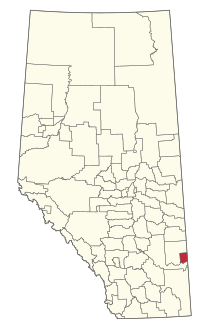 | |
| Athabasca County | January 1, 1947 | 13 | 9 | 7,869 | 7,662 | 2.7 | 6,124.43 | 1.3 |  | |
| County of Barrhead No. 11 | January 1, 1955 | 13 | 7 | 6,288 | 6,096 | 3.1 | 2,406.25 | 2.6 |  | |
| Beaver County | February 1, 1943 | 10 | 5 | 5,905 | 5,689 | 3.8 | 3,317.57 | 1.8 | 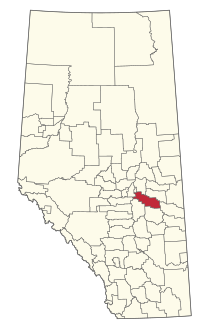 | |
| Big Lakes County | January 1, 1995 | 17 | 9 | 3,861 (2013) | 5,672 | 5,912 | −4.1 | 13,942.43 | 0.4 |  |
| MD of Bighorn No. 8 | January 1, 1988 | 15 | 5 | 1,334 | 1,341 | −0.5 | 2,761.18 | 0.5 | 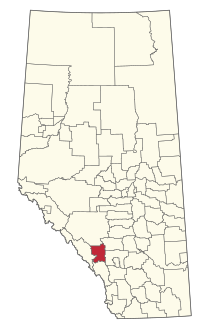 | |
| Birch Hills County | January 1, 1995 | 19 | 7 | 1,553 | 1,582 | −1.8 | 2,859.60 | 0.5 |  | |
| MD of Bonnyville No. 87 | January 1, 1955 | 12 | 7 | 11,836 (2014) | 13,575 | 11,191 | 21.3 | 6,064.73 | 2.2 | 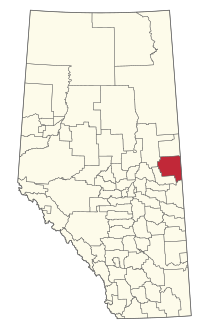 |
| Brazeau County | July 1, 1988 | 11 | 7 | 7,771 | 7,132 | 9.0 | 3,005.35 | 2.6 |  | |
| Camrose County | January 1, 1944 | 10 | 7 | 8,458 | 8,004 | 5.7 | 3,324.21 | 2.5 | 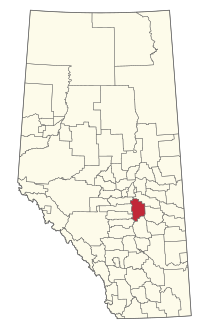 | |
| Cardston County | January 1, 1954 | 3 | 7 | 4,481 | 4,167 | 7.5 | 3,429.82 | 1.3 | 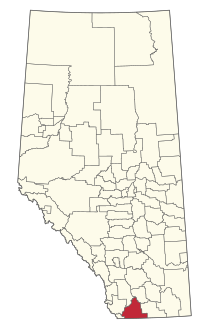 | |
| Clear Hills County | January 1, 1995 | 17 | 7 | 2,829 (2012) | 3,023 | 2,801 | 7.9 | 15,125.49 | 0.2 | 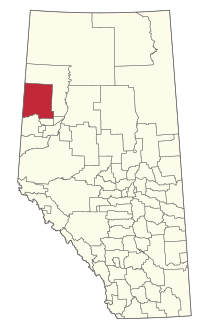 |
| Clearwater County | January 1, 1985 | 9 | 7 | 11,947 | 12,278 | −2.7 | 18,682.45 | 0.6 | 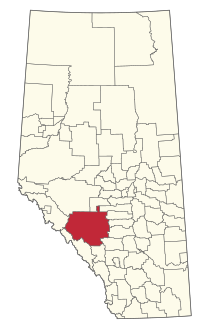 | |
| Cypress County | January 1, 1985 | 1 | 9 | 7,662 | 7,214 | 6.2 | 13,173.25 | 0.6 | 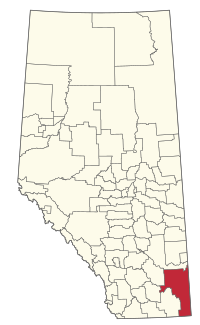 | |
| MD of Fairview No. 136 | December 9, 1914 | 19 | 5 | 1,604 | 1,673 | −4.1 | 1,387.58 | 1.2 | 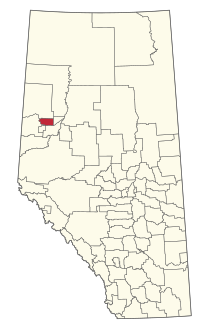 | |
| Flagstaff County | January 1, 1944 | 7 | 7 | 3,738 | 3,591 | 4.1 | 4,067.58 | 0.9 | 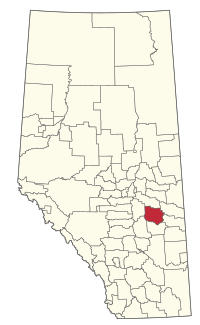 | |
| Foothills County | January 1, 1954 | 6 | 7 | 22,766 | 21,248 | 7.1 | 3,636.8 | 6.3 | 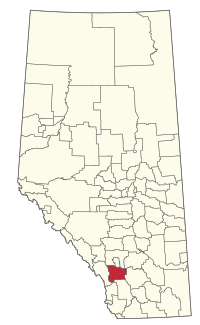 | |
| County of Forty Mile No. 8 | January 1, 1954 | 1 | 7 | 3,581 | 3,336 | 7.3 | 7,249.31 | 0.5 | 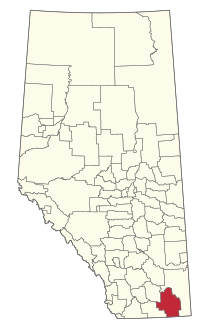 | |
| County of Grande Prairie No. 1 | December 21, 1943 | 19 | 9 | 22,303 | 19,724 | 13.1 | 5,802.21 | 3.8 |  | |
| MD of Greenview No. 16 | January 1, 1994 | 18 | 8 | 5,583 | 5,299 | 5.4 | 32,984.24 | 0.2 | 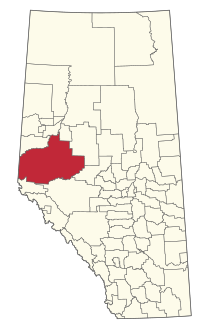 | |
| Kneehill County | January 1, 1944 | 5 | 7 | 5,001 | 4,921 | 1.6 | 3,381.02 | 1.5 |  | |
| Lac Ste. Anne County | January 1, 1944 | 13 | 7 | 10,899 | 10,260 | 6.2 | 2,850.38 | 3.8 | 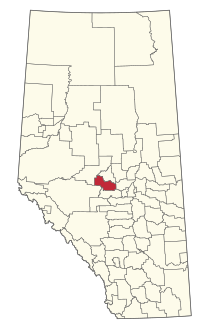 | |
| Lacombe County | January 1, 1944 | 8 | 7 | 10,343 | 10,307 | 0.3 | 2,765.16 | 3.7 | 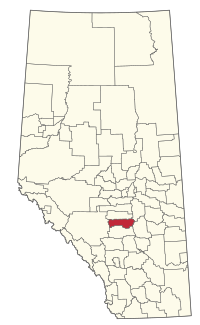 | |
| Lamont County | January 1, 1944 | 10 | 5 | 3,899 | 3,872 | 0.7 | 2,385.09 | 1.6 | 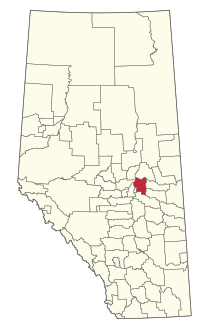 | |
| Leduc County | January 1, 1944 | 11 | 7 | 13,780 | 13,494 | 2.1 | 2,601.49 | 5.3 |  | |
| MD of Lesser Slave River No. 124 | January 1, 1995 | 17 | 7 | 2,803 | 2,929 | −4.3 | 10,074.39 | 0.3 | 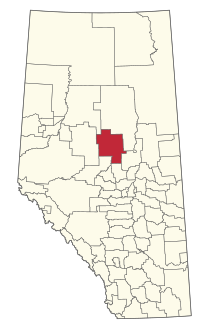 | |
| Lethbridge County | January 1, 1954 | 2 | 7 | 10,353 | 10,046 | 3.1 | 2,836.64 | 3.6 | 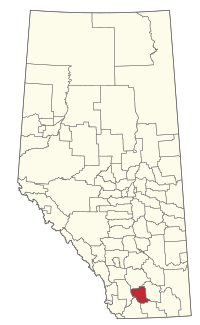 | |
| County of Minburn No. 27 | January 30, 1942 | 10 | 7 | 3,188 | 3,383 | −5.8 | 2,913.02 | 1.1 | 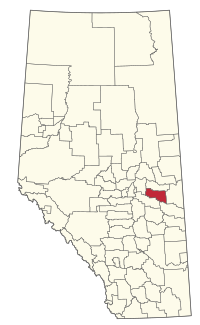 | |
| Mountain View County | January 1, 1944 | 6 | 7 | 13,074 | 12,359 | 5.8 | 3,782.64 | 3.5 | 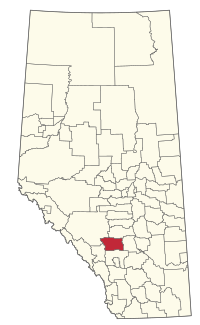 | |
| County of Newell | January 1, 1953 | 2 | 10 | 7,524 | 7,138 | 5.4 | 5,904.67 | 1.3 | 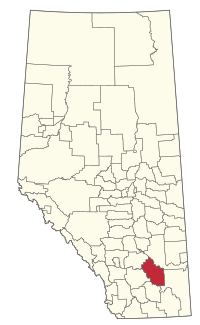 | |
| County of Northern Lights | January 1, 1995 | 17 | 7 | 4,200 | 4,117 | 2.0 | 20,755.37 | 0.2 | 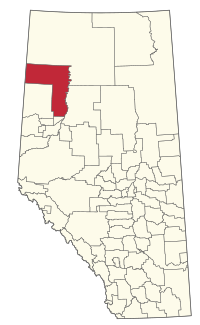 | |
| Northern Sunrise County | April 1, 1994 | 17 | 6 | 1,933 (2013) | 1,891 | 1,791 | 5.6 | 21,150.97 | 0.1 | 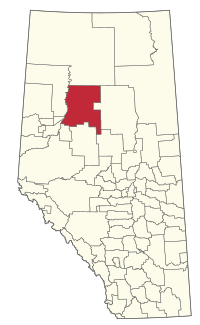 |
| MD of Opportunity No. 17 | August 1, 1995 | 17 | 11 | 2,639 (2016) | 3,181 | 3,074 | 3.5 | 29,142.10 | 0.1 | 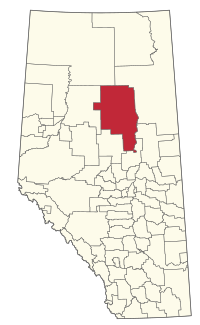 |
| County of Paintearth No. 18 | January 1, 1944 | 7 | 7 | 2,102 | 2,029 | 3.6 | 3,283.36 | 0.6 | 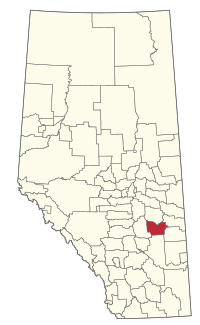 | |
| Parkland County | January 1, 1969 | 11 | 7 | 32,097 | 30,568 | 5.0 | 2,390.23 | 13.4 | 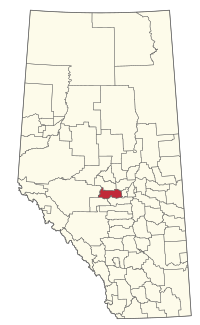 | |
| MD of Peace No. 135 | December 11, 1916 | 19 | 5 | 1,747 | 1,446 | 20.8 | 847.47 | 2.1 | 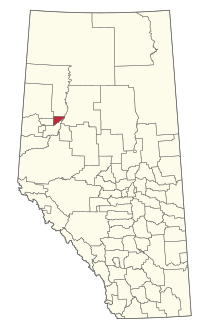 | |
| MD of Pincher Creek No. 9 | January 1, 1944 | 3 | 5 | 2,965 | 3,158 | −6.1 | 3,482.05 | 0.9 | 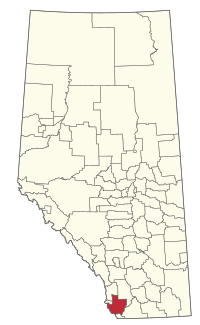 | |
| Ponoka County | January 1, 1952 | 8 | 5 | 9,806 | 8,856 | 10.7 | 2,814.26 | 3.5 |  | |
| MD of Provost No. 52 | March 1, 1943 | 7 | 7 | 2,205 | 2,288 | −3.6 | 3,628.39 | 0.6 | 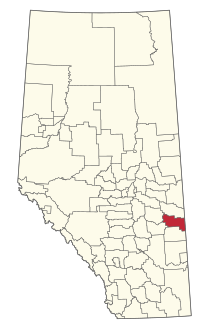 | |
| MD of Ranchland No. 66 | January 1, 1995 | 15 | 3 | 104 (2013) | 92 | 79 | 16.5 | 2,638.70 | 0 | 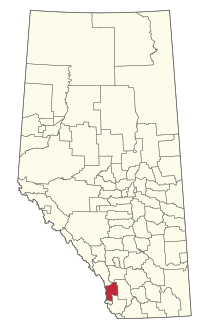 |
| Red Deer County | January 1, 1944 | 8 | 7 | 19,541 | 18,316 | 6.7 | 3,961.85 | 4.9 |  | |
| Rocky View County | January 1, 1955 | 6 | 9 | 38,055[32] (2013) | 39,407 | 35,754 | 10.2 | 3,836.33 | 10.3 |  |
| Saddle Hills County | January 1, 1995 | 19 | 7 | 2,225 | 2,288 | −2.8 | 5,838.15 | 0.4 |  | |
| Smoky Lake County | March 1, 1943 | 12 | 5 | 4,107 | 3,910 | 5.0 | 3,412.92 | 1.2 |  | |
| MD of Smoky River No. 130 | January 1, 1952 | 19 | 6 | 2,023 | 2,126 | −4.8 | 2,840.14 | 0.7 |  | |
| MD of Spirit River No. 133 | December 11, 1916 | 19 | 4 | 700 | 713 | −1.8 | 683.60 | 1 | 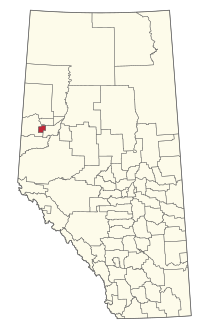 | |
| County of St. Paul No. 19 | January 30, 1942 | 12 | 7 | 6,168 (2012) | 5,827 | 5,405 | 7.8 | 3,309.44 | 1.8 | 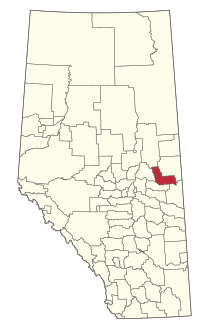 |
| Starland County | February 1, 1943 | 5 | 5 | 2,071 (2013) | 2,066 | 2,057 | 0.4 | 2,559.95 | 0.8 | 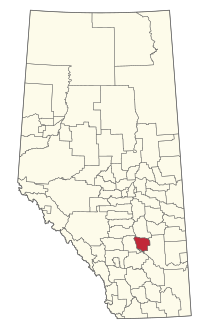 |
| County of Stettler No. 6 | March 1, 1943 | 7 | 7 | 5,322 | 5,103 | 4.3 | 4,018.84 | 1.3 | 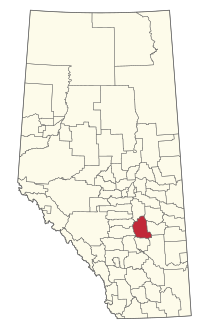 | |
| Sturgeon County | January 1, 1955 | 11 | 7 | 20,495 | 19,578 | 4.7 | 2,090.13 | 9.8 | 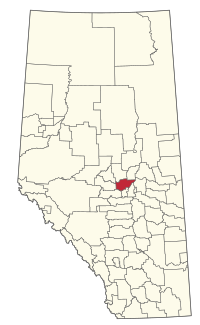 | |
| MD of Taber | January 1, 1954 | 2 | 7 | 7,173 (2016) | 7,098 | 6,851 | 3.6 | 4,201.65 | 1.7 |  |
| Thorhild County | January 1, 1955 | 13 | 5 | 3,254 | 3,417 | −4.8 | 2,001.74 | 1.6 |  | |
| County of Two Hills No. 21 | January 1, 1944 | 10 | 5 | 3,322 | 3,160 | 5.1 | 2,637.18 | 1.3 |  | |
| County of Vermilion River | January 1, 1944 | 10 | 7 | 8,116 (2015) | 8,267 | 7,905 | 4.6 | 5,519.75 | 1.5 | 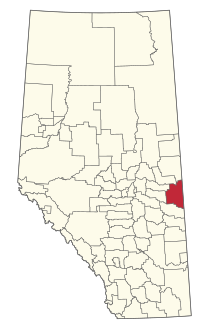 |
| Vulcan County | January 1, 1951 | 5 | 7 | 3,839 (2012) | 3,984 | 3,875 | 2.8 | 5,433.43 | 0.7 | 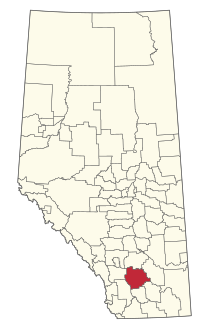 |
| MD of Wainwright No. 61 | January 30, 1942 | 7 | 7 | 4,479 | 4,138 | 8.2 | 4,156.56 | 1.1 |  | |
| County of Warner No. 5 | January 1, 1954 | 2 | 7 | 3,847 | 3,841 | 0.2 | 4,531.55 | 0.8 |  | |
| Westlock County | February 1, 1943 | 13 | 7 | 7,220 | 7,644 | −5.5 | 3,171.83 | 2.3 | 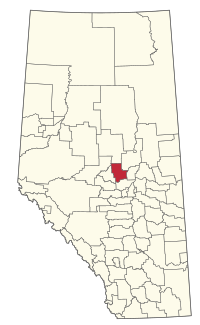 | |
| County of Wetaskiwin No. 10 | February 1, 1943 | 11 | 7 | 11,181 | 10,866 | 2.9 | 3,132.06 | 3.6 | 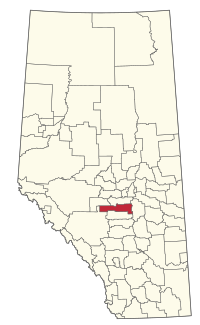 | |
| Wheatland County | January 1, 1955 | 5 | 7 | 8,788 | 8,285 | 6.1 | 4,545.92 | 1.9 |  | |
| MD of Willow Creek No. 26 | January 1, 1954 | 3 | 7 | 5,179 | 5,107 | 1.4 | 4,558.14 | 1.1 | 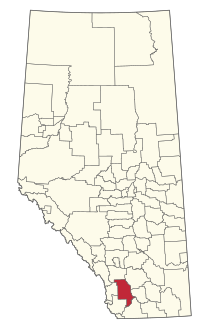 | |
| Woodlands County | January 1, 1994 | 13 | 7 | 4,612 (2014) | 4,754 | 4,306 | 10.4 | 7,669.13 | 0.6 | 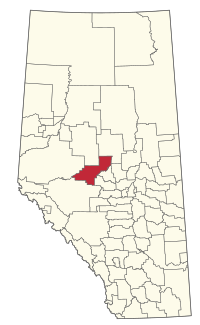 |
| Yellowhead County | January 1, 1994 | 14 | 9 | 10,995 | 10,469 | 5.0 | 22,293.16 | 0.5 |  | |
| Total municipal districts | — | — | 437 | — | 479,167 | 4,560,664 | 5.1 | 399,087.25 | 1.2 | |
Improvement districts
According to Section 581 of the Municipal Government Act (MGA), Alberta's Lieutenant Governor in Council, on the recommendation of the Minister of Municipal Affairs, may form an improvement district. Section 582 of the MGA requires that the order to form an improvement district must describe its boundaries and give it an official name.
Alberta currently has eight improvement districts, which have a combined population totaling 2,146.[33] Five of them are located within national parks, and two are within provincial parks.
| Improvement districts of Alberta | ||||||||
|---|---|---|---|---|---|---|---|---|
| Name | Incorporation date (improvement district)[34] |
Population (2011)[33] |
Population (2006)[33] |
Change (%)[33] | Land area (km2)[33] |
Population density (per km2)[33] |
Remarks | |
| Improvement District No. 4 (Waterton) | January 1, 1944 | 88 | 160 | −45.0 | 480.58 | 0.18 | Coincident with Waterton Lakes National Park | |
| Improvement District No. 9 (Banff) | April 1, 1945 | 1,175 | 938 | 25.3 | 6,782.23 | 0.17 | Coincident with Banff National Park excluding the Town of Banff | |
| Improvement District No. 12 (Jasper National Park) | April 1, 1945 | 34 | 24 | 41.7 | 10,181.58 | 0.003 | Coincident with Jasper National Park excluding the Municipality of Jasper | |
| Improvement District No. 13 (Elk Island) | April 1, 1958 | 10 | 21 | −52.4 | 165.28 | 0.06 | Coincident with Elk Island National Park | |
| Improvement District No. 24 (Wood Buffalo) | January 1, 1967 | 590 | 422 | 39.8 | 33,412.25 | 0.02 | Coincident with the Alberta portion of Wood Buffalo National Park excluding Peace Point 222 | |
| Improvement District No. 25 (Willmore Wilderness) | January 2, 1994 | 0 | 0 | — | 4,604.97 | 0.0 | Coincident with Willmore Wilderness Park | |
| Improvement District No. 349 | January 1, 2012 | 0[35] | — | — | 5,804.56 | 0.0 | Consists mostly of the Alberta portion of the Cold Lake Air Weapons Range | |
| Kananaskis Improvement District | January 1, 1983 | 249 | 429 | −42.0 | 4,210.72 | 0.06 | Consists mostly of Kananaskis Country | |
| Total improvement districts | — | 2,146 | 1,994 | 7.6 | 65,642.17 | 0.03 | — | |
In September 2011, the Province of Alberta approved the formation of a new improvement district named Improvement District No. 349.[36] It is located north of the City of Cold Lake and includes the Cold Lake Air Weapons Range from Lac La Biche County and some adjacent lands further to the north from the Regional Municipality of Wood Buffalo.[36][37][38] The effective incorporation date of Improvement District No. 349 was January 1, 2012.[36]
Special areas
Special areas are rural municipalities created in 1938 under the authority of the Special Areas Act.[2][5] A special area is not to be confused with a specialized municipality, which is a completely different municipal status.
Alberta's three special areas had a combined population totalling 4,499 in 2011.[4]
| Special areas of Alberta | |||||||
|---|---|---|---|---|---|---|---|
| Name | Incorporation date (special area)[39] |
Population (2011)[33] |
Population (2006)[33] |
Change (%)[33] | Area (km²)[33] | Population density (/km²)[33] | |
| Special Area No. 2 | April 7, 1959 | 2,025 | 2,074 | −2.4 | 9,342.42 | 0.22 | |
| Special Area No. 3 | April 7, 1959 | 1,122 | 1,266 | −11.4 | 6,623.96 | 0.17 | |
| Special Area No. 4 | January 1, 1969 | 1,352 | 1,389 | −2.7 | 4,403.03 | 0.31 | |
| Total special areas | — | 4,499 | 4,729 | −4.9 | 20,369.41 | 0.22 | |
Unincorporated communities
Urban service areas
An urban service area is a type of hamlet that is not officially defined under the Municipal Government Act (MGA). However, the Province of Alberta recognizes it as equivalent to a city for the purposes of program delivery and grant eligibility according to the Orders in Council that established the Regional Municipality (RM) of Wood Buffalo and Strathcona County as specialized municipalities.[40][41]
These Orders in Council (see Schedule 1, Section 7[40] and Schedule 1, Section 3[41] respectively) also state that:
- the specialized municipalities shall provide to the Province of Alberta any information required to administer programs or to determine the amount of grants which would have been paid if the urban service areas were incorporated cities; and
- for the purposes of enactments affecting roads, culverts, ditches, drains, and highways, the urban service areas are deemed to be cities.
Essentially, urban services areas meet the eligibility requirements of the MGA to incorporate as a city. As such, they are Alberta's largest hamlets.
There are currently two urban services areas in Alberta:
- Fort McMurray; and
- Sherwood Park.
Fort McMurray, within the jurisdiction of the RM of Wood Buffalo, was formerly a city prior its amalgamation with Improvement District No. 143 on April 1, 1995. It was designated an urban service area at the time of the amalgamation.[40]
Sherwood Park has always been an unincorporated community under the jurisdiction of Strathcona County. It became an urban service area when Strathcona County changed its status from a municipal district to a specialized municipality on January 1, 1996.[41]
Hamlets
According to Section 59 of the Municipal Government Act (MGA), hamlets are unincorporated communities that:
- consist of five or more buildings used as dwellings, a majority of which are on parcels of land smaller than 1,850 m2;
- have a generally accepted boundary and name; and
- contain parcels of land that are used for non‑residential purposes.[1]
Further, Section 59 of the MGA provides the councils of municipal districts (or counties) and specialized municipalities the authority to designate unincorporated communities within its boundaries as hamlets.[1][5] Hamlets may also be designated within improvement districts and special areas by the Minister of Municipal Affairs pursuant to Section 590 of the MGA and Section 10 of the Special Areas Act respectively.[1][2]
When a hamlet's population reaches 300, it becomes eligible to incorporate as a village under Section 80 of the MGA, so long as the majority of the buildings are still on parcels of land smaller than 1,850 m2.[1] However, it is a modern-day rarity for a hamlet to incorporate as a village – Barnwell and Wabamun were the last two to do so both on January 1, 1980. It is much more common these days for villages to revert to hamlet status through the dissolution process instead.
There are currently 389 hamlets in Alberta, two of which are the urban services areas presented above.[42]
Townsites
A townsite is a type of unincorporated community that is not officially defined under the Municipal Government Act (MGA), but it is generally regarded as an independent urban area within an Indian reserve that is comparable in population, land area, services, and built form, to that of Alberta's incorporated towns. Essentially, townsites would meet the eligibility requirements of the MGA to incorporate as a town if they were not located on Indian reserve lands under federal jurisdiction.
Redwood Meadows is Alberta's only townsite at this time and is located within the Tsuu T'ina Nation.
Other unincorporated communities
Métis settlements
Métis settlements are rural areas inhabited by Indigenous Métis people in Alberta and were established and recognized in 1936 under the Métis Population Betterment Act. The settlements provide an autonomous land base, allow better access to education, health and other social services, and provide economic development opportunities for the only recognized Métis land-base in Canada.[3] Métis settlements now operate under the authority of the Métis Settlements Act.[5] These eight Métis settlements are governed by a unique Métis government known as the Métis Settlements General Council (MSGC).
Alberta currently has eight Métis settlements, all of which are located in the northern half of the province. The official names of the eight settlements, and the municipal districts they are within, are as follows:
| Métis settlements of Alberta | ||||||
|---|---|---|---|---|---|---|
| Name | Municipal district or specialized municipality [95][26] |
Population (2016)[96] |
Population (2011)[96] |
Change (%)[96] |
Land area (km²)[96] |
Population density (per km2)[96] |
| Buffalo Lake | Smoky Lake County | 712 | 492 | +44.7% | 336.97 | 2.1/km2 |
| East Prairie | Big Lakes County | 304 | 366 | −16.9% | 334.44 | 0.9/km2 |
| Elizabeth | MD of Bonnyville No. 87 | 653 | 654 | −0.2% | 252.44 | 2.6/km2 |
| Fishing Lake | MD of Bonnyville No. 87 | 446 | 436 | +2.3% | 355.51 | 1.3/km2 |
| Gift Lake[lower-alpha 2] | Big Lakes County Northern Sunrise County | 658 | 662 | −0.6% | 812.73 | 0.8/km2 |
| Kikino[lower-alpha 3] | Smoky Lake County Lac La Biche County | 934 | 964 | −3.1% | 443.57 | 2.1/km2 |
| Paddle Prairie | County of Northern Lights | 544 | 562 | −3.2% | 1,738.82 | 0.3/km2 |
| Peavine | Big Lakes County | 607 | 690 | −12.0% | 816.38 | 0.7/km2 |
| Total Metis settlements | — | 4,858 | 4,826 | +0.7% | 5,090.86 | 1.0/km2 |
- *Areas generated from provincial Métis settlement boundary data.
Very small portions of the Gift Lake Métis Settlement and the Kikino Métis Settlement are also located within Northern Sunrise County and Lac La Biche County respectively.
Alberta's eight Métis settlements have a combined population totalling 4,858 as of 2012.[4]
Indian reserves
Indian reserves in Alberta cover a total area of 1,622,630 acres (6,566.6 km2) and range in size from 1,089 acres (4.41 km2) to 354,667 acres (1,435.29 km2).[5] Under the Constitution Act, 1982, legislative authority over Indian reserves is allocated to the Parliament of Canada. The Government of Canada exercises executive authority over Indian reserves through the Department of Indian Affairs and Northern Development. Local administration is exercised by Band councils whose members are elected by members of the reserve.
See also
Notes
- Beaumont is Alberta's newest city, incorporated on January 1, 2019. Based on 2016 data, Beaumont is Alberta's smallest city by land area, but in 2017 its area increased to nearly 2,400 hectares, making it larger than Wetaskiwin and Lacombe.[6]
- Calgary is Canada's third-largest city, Alberta's largest city by both population and area, and was Alberta's first city, incorporated on January 1, 1894. The Calgary census metropolitan area (CMA) includes the cities of Airdrie, Calgary and Chestermere.
- Chestermere was known as Chestermere Lake prior to March 1, 1993.[6]
- Edmonton is Canada's fifth-largest city and Alberta's capital. The Edmonton CMA includes the cities of Beaumont, Edmonton, Fort Saskatchewan, Leduc, Spruce Grove and St. Albert.
- The balance of Lloydminster is located within Saskatchewan.
- This 2016 population does not include 11,765 in the Saskatchewan portion of Lloydminster. The city's total population in 2016 was 31,410.
- This 2011 population does not include 9,772 in the Saskatchewan portion of Lloydminster. The city's total population in 2011 was 27,804.
- This area does not include 18.28 km2 (7.06 sq mi) in the Saskatchewan portion of Lloydminster. The city's total land area in 2011 was 42.32 km2 (16.34 sq mi).
- Wetaskiwin is Alberta's smallest city by population and land area.
- Athabasca was formerly known as Athabasca Landing prior to August 4, 1913.[10]
- Drumheller originally incorporated as a city on April 3, 1930 but reverted from city status as a result of its amalgamation with the M.D. of Badlands No. 7 in 1998.[10]
- Fort Macleod was formerly known as Macleod prior to April 1, 1952.[10]
- Peace River was formerly known as Peace River Crossing prior to May 22, 1916.[10]
- St. Paul was formerly known as St. Paul de Métis prior to December 15, 1932.
- Bittern Lake was formerly known as Rosenroll prior to December 16, 1911.[19]
- Delia was formerly known as Highland prior to December 9, 1915.[20]
- Hay Lakes was formerly known as Hay Lake prior to January 1, 1932.
- Ryley was also known as Equity in 1909.[21]
- Spring Lake was formerly known as Edmonton Beach prior to January 1, 1999.[22]
- Stirling is designated a national historic site.
- Bellis dissolved from village status on December 31, 1945.
- Blackie dissolved from village status on August 31, 1997.
- Burdett dissolved from village status on January 1, 2003.
- Cadogan dissolved from village status on December 31, 1945.
- Calling Lake's population includes the designated places of Calling Lake (299) and Centre Calling Lake (149).[46]
- Referred to as Campsie Cove by Statistics Canada in the 1991 census.[48]
- Cayley dissolved from village status on June 1, 1996.
- Chinook dissolved from village status on April 1, 1977.
- Clairmont dissolved from village status on December 31, 1945.
- Cluny dissolved from village status on September 15, 1995.
- Cochrane Lake is also known as Cochrane Lake Subdivision.
- Colinton's population includes the designated places of Colinton (201) and McNabb's (48), as defined by Statistics Canada,[46] which are both included within the hamlet boundary, as defined by Athabasca County.[60][61]
- Compeer dissolved from village status on December 31, 1936.
- Craigmyle dissolved from village status on January 1, 1972.
- Cynthia dissolved from town status on May 1, 1959.
- Dead Man's Flats is also known as Pigeon Mountain.
- Derwent dissolved from village status on September 1, 2010.[16]
- Diamond City dissolved from village status on June 30, 1937.
- Dunmore dissolved from village status on February 4, 1919.
- Eaglesham dissolved from village status on December 31, 1996.
- Enchant dissolved from village status on January 30, 1945.
- Entwistle dissolved from village status on December 31, 2000.
- Erskine dissolved from village status on May 20, 1946.
- Evansburg dissolved from village status on June 30, 1998.
- Ferintosh dissolved from village status on January 1, 2020.
- For Assiniboine dissolved from village status on December 31, 1991.
- Fort McKay's population does not include portion of community on Indian reserve.
- Fort McMurray is one of two hamlets designated an urban service area.
- Fort McMurray's population excludes 3,559 non-permanent residents.[50]
- Fort Vermilion's population of 763 is slightly understated as it only represents the Ward 7 portion of the hamlet. A small western portion of the hamlet is located with Ward 6.[67]
- Galahad dissolved from village status on January 1, 2016.[69]
- Gleichen dissolved from town status on March 31, 1998.
- Goose Lake is also known as Lone Pine.
- Grande Cache dissolved from town status on January 1, 2019.[73]
- Grassy Lake dissolved from village status on July 1, 1996.
- Grouard, also known as Grouard Mission, dissolved from village status on January 18, 1944.
- Hairy Hill dissolved from village status on December 31, 1996.
- Hairy Hill's population is from the 2001 federal census (Statistics Canada did not publish its population in the 2006, 2011 or 2016 federal censuses).
- Half Moon Lake is also known as Half Moon Estates.
- Irvine dissolved from town status on December 31, 1996.
- Islay dissolved from village status on March 2, 1944.
- Janvier South is also known as Janvier and Chard.
- Jenner dissolved from village status on June 22, 1943.
- Kinuso dissolved from village status on September 1, 2009.
- La Crete's population of 3,376 is understated as it only represents the Ward 3 portion of the hamlet, which is generally west of 99 Street.[77]
- Lac La Biche dissolved from town status on August 1, 2007 as a result of its amalgamation with Lakeland County to form Lac La Biche County.[78]
- Langdon dissolved from village status on December 31, 1945.
- Lavoy dissolved from village status on April 30, 1999.
- Lodgepole dissolved from new town status on March 1, 1970.
- Referred to as Lottie Lake Development by Statistics Canada in the 1991 census.[48]
- Statistics Canada cautioned that Metiskow's population from the 1991 census may be an estimate.[48]
- Minburn dissolved from village status on July 1, 2015.[84]
- Mirror dissolved from village status on January 1, 2004.
- Monarch dissolved from village status on December 31, 1938.
- Monitor dissolved from village status on December 31, 1945.
- Mountain View dissolved from village status on September 9, 1915.
- Mulhurst Bay is also known as Mulhurst.
- Mulhurst Bay's population includes the designated places of Mulhurst part A (334) and Mulhurst part B (0).[46]
- New Norway dissolved from village status on November 1, 2012.[86]
- New Sarepta dissolved from village status on September 1, 2010.[17]
- Ohaton dissolved from village status on December 31, 1945.
- Plamondon dissolved from village status on May 1, 2002.
- Radway dissolved from village status on December 31, 1996.
- Ranfurly dissolved from village status on December 31, 1945.
- Richdale dissolved from village status on June 2, 1931.
- Rosebud dissolved from village status on December 31, 1945.
- Rumsey dissolved from village status on January 1, 1995.
- Sandy Lake is also known as Pelican Mountain.
- Sangudo dissolved from village status on September 16, 2007.
- Sherwood Park is one of two hamlets designated an urban service area.
- Strome dissolved from village status on January 1, 2016.[90]
- Suffield dissolved from village status on January 1, 1930.
- Swalwell dissolved from village status on December 31, 1945.
- Thorhild dissolved from village status on March 18, 2009.
- Tilley dissolved from village status on August 31, 2013.[92]
- Torrington dissolved from village status on January 1, 1998.
- Wabasca was formerly named Wabasca-Desmarais.
- Wabasca's population includes the designated places of Desmarais (74) and Wabasca (1,406)[46] and the Desmarais Indian settlement (105),[53] all of which are located within the hamlet boundary.[60][94]
- Statistics Canada cautioned that Wagner's population from the 1991 census may be an estimate.[48]
- Walsh dissolved from village status on April 30, 1925.
- Wanham dissolved from village status on December 31, 1999.
- Warspite dissolved from village status on June 1, 2000.
- Wildwood dissolved from village status on December 31, 1990.
- Statistics presented for six municipal districts (the Big Lakes County, the MD of Bonnyville No. 87, Lac La Biche County, the County of Northern Lights, Northern Sunrise County and Smoky Lake County) differ from statistics for their corresponding census subdivisions published by Statistics Canada to recognize that Alberta's eight Metis settlements, which are designated places located within these six municipal districts, are separate municipalities.[26] The statistics presented for total municipal districts and total rural municipalities therefore exclude the statistics associated with the eight Metis settlements.
- Gift Lake comprises two parts. The majority is located within Big Lakes County, while the balance is located within Northern Sunrise County. The Big Lakes County portion (part "A") had a population of 658 living on 811.68 km2 (313.39 sq mi) in 2016, while the Northern Sunrise County portion (part "B") had a population of 0 living on 1.05 km2 (0.41 sq mi).[96]
- Kikino comprises two parts. The majority is located within Smoky Lake County, while the balance is located within Lac La Biche County. The Smoky Lake County portion (part "A") had a population of 934 living on 442.27 km2 (170.76 sq mi) in 2016, while the Lac La Biche County portion (part "B") had a population of 0 living on 1.30 km2 (0.50 sq mi).[96]
References
- "Municipal Government Act". Alberta Queen's Printer. Retrieved December 6, 2009.
- "Special Areas Act". Alberta Queen's Printer. Retrieved December 6, 2009.
- "Metis Settlements Act". Alberta Queen's Printer. Retrieved December 6, 2009.
- "Alberta 2012 Official Population List" (PDF). Alberta Municipal Affairs. November 22, 2012. Retrieved March 6, 2013.
- "Types of Municipalities in Alberta". Alberta Municipal Affairs and Housing. May 16, 2008. Retrieved December 18, 2008.
- "City Municipal Profiles" (PDF). Alberta Municipal Affairs. April 17, 2019. Retrieved April 17, 2019.
- "Population and dwelling counts, for Canada, provinces and territories, and census subdivisions (municipalities), 2016 and 2011 censuses – 100% data (Alberta)". Statistics Canada. February 8, 2018. Retrieved January 12, 2019.
- "O.C. 499/2014". Government of Alberta. December 19, 2014. Retrieved January 1, 2015.
- "Communities Within Specialized and Rural Municipalities" (PDF). Alberta Municipal Affairs. April 9, 2013. Retrieved May 21, 2013.
- "Municipal Profiles: Summary Reports (Towns)" (PDF). Alberta Municipal Affairs. May 17, 2013. Retrieved May 21, 2013.
- "Population and dwelling count amendments, 2016 Census". Statistics Canada. January 16, 2018. Retrieved February 3, 2018.
- "Census Profile - Map : Canmore, Town (Census Subdivision), Alberta". Statistics Canada. March 22, 2013. Retrieved May 21, 2013.
- "Census Profile - Map : Drumheller, Town (Census Subdivision), Alberta". Statistics Canada. March 22, 2013. Retrieved May 21, 2013.
- "Census Profile - Map : Peace River, Town (Census Subdivision), Alberta". Statistics Canada. March 22, 2013. Retrieved May 21, 2013.
- "Order in Council (O.C.) 344/2016" (PDF). Province of Alberta. December 13, 2016. Retrieved December 15, 2016.
- "Order in Council (O.C.) 229/2010". Alberta Queen's Printer. Retrieved July 15, 2010.
- "Order in Council (O.C.) 230/2010". Alberta Queen's Printer. Retrieved July 15, 2010.
- "Population and dwelling counts, for Canada, provinces and territories, and census subdivisions (municipalities), 2011 and 2006 censuses (Alberta)". Statistics Canada. August 9, 2016. Retrieved November 5, 2016.
- "Order in Council (O.C.) 979/11" (PDF). Alberta Municipal Affairs. December 16, 1911. Retrieved July 26, 2010.
- "Change in Name of Village Municipality - Highland to Delia" (PDF). Alberta Municipal Affairs. December 9, 1915. Retrieved July 26, 2010.
- "The Village of Ryley - Equity". Village of Ryley. Archived from the original on February 22, 2012. Retrieved April 13, 2010.
- "Order in Council (O.C.) 517/98". Alberta Municipal Affairs. December 9, 1998. Retrieved July 26, 2010.
- "Census Profile, 2016 Census". Statistics Canada. September 13, 2017. Retrieved September 26, 2017.
- "Municipal Profiles (Specialized Municipalities)" (PDF). Alberta Municipal Affairs. December 27, 2013. Retrieved December 30, 2013.
- "Population and dwelling counts, for Canada, provinces and territories, and census subdivisions (municipalities), 2016 and 2011 censuses – 100% data (Alberta)". Statistics Canada. February 8, 2017. Retrieved February 8, 2017.
- "Population and dwelling counts, for Canada, provinces and territories, census divisions, census subdivisions (municipalities) and designated places, 2011 and 2006 censuses". Statistics Canada. January 30, 2013. Retrieved November 4, 2013.
- "O.C. 259/2017". Government of Alberta. September 14, 2017. Retrieved December 31, 2017.
- "O.C. 396/2018". Government of Alberta. December 11, 2018. Retrieved May 16, 2020.
- "Municipal Profiles (Municipal Districts)" (PDF) (PDF). Alberta Municipal Affairs. January 3, 2014. Retrieved January 5, 2014.
- "2016 Municipal Affairs Population List" (PDF). Alberta Municipal Affairs. ISBN 978-1-4601-3127-5. Archived from the original (PDF) on January 16, 2017. Retrieved February 7, 2017.
- "Population and dwelling counts, for Canada, provinces and territories, and census subdivisions (municipalities), 2016 and 2011 censuses (Alberta)". Statistics Canada. February 8, 2017. Retrieved August 9, 2017.
- "Rocky View's Total Population Results are In". Rocky View County. August 30, 2013. Retrieved August 31, 2013.
- "Population and dwelling counts, for Canada, provinces and territories, and census subdivisions (municipalities), 2011 and 2006 censuses (Alberta)". Statistics Canada. August 9, 2016. Retrieved November 5, 2016.
- "Municipal Profiles (Improvement Districts)" (PDF). Alberta Municipal Affairs. May 31, 2013. Retrieved June 5, 2013.
- "Interim List of Changes to Municipal Boundaries, Status, and Names From January 2, 2011 to January 1, 2012 (Table 1 - Changes to census subdivisions in alphabetical order by province and territory)" (XLSX). Statistics Canada. November 14, 2012. Retrieved June 6, 2013.
- "O.C. 419/2011". Province of Alberta. September 9, 2011. Retrieved September 12, 2011.
- Kostiw, Tanya (August 16, 2011). "Air Weapons Range to become improvement district under proposed deal". Bonnyville Nouvelle. Great West Newspapers Limited Partnership. Archived from the original on December 18, 2013. Retrieved August 16, 2011.
- Stodalka, William (August 16, 2011). "City council sees draft of potential air range deal". Cold Lake Sun. Sun Media Corporation. Archived from the original on September 1, 2011. Retrieved August 16, 2011.
- "Municipal Profiles (Special Areas)" (PDF). Alberta Municipal Affairs. May 31, 2013. Retrieved June 5, 2013.
- "Order in Council 817/94 (RM of Wood Buffalo status change to specialized municipality)" (PDF). Province of Alberta. December 21, 1994. Retrieved February 15, 2010.
- "Order in Council 761/95 (Strathcona County status change to specialized municipality)" (PDF). Province of Alberta. December 6, 1995. Retrieved February 15, 2010.
- "2012 Municipal Codes" (PDF). Alberta Municipal Affairs. December 28, 2012. Retrieved March 6, 2013.
- "Municipal Codes" (PDF). of Alberta Municipal Affairs. March 31, 2020. p. 7 of 13. Retrieved May 12, 2020.
- "Specialized and Rural Municipalities and Their Communities" (PDF). Alberta Municipal Affairs. January 14, 2019. Retrieved January 14, 2019.
- "2009 Municipal Census Report" (PDF). County of Thorhild. August 11, 2009. Archived from the original (PDF) on July 20, 2011. Retrieved March 6, 2013.
- "Population and dwelling counts, for Canada, provinces and territories, and designated places, 2016 and 2011 censuses – 100% data (Alberta)". Statistics Canada. February 20, 2019. Retrieved February 2, 2020.
- "Alberta Population Summary: Alberta's Hamlets Alphabetically, 2010" (PDF). Alberta Population. Retrieved February 7, 2020.
- "91 Census: Unincorporated Places — Population and Dwelling Counts" (PDF). Statistics Canada. June 1993. Retrieved February 23, 2020.
- "Census 2018 Results Report" (PDF). Strathcona County. August 30, 2018. pp. 3–4. Retrieved February 2, 2020.
- "census2018 Municipal Census Report" (PDF). Regional Municipality of Wood Buffalo. Retrieved February 2, 2020.
- "Lac La Biche County 2016 Municipal Census Report". Lac La Biche County. p. 13. Retrieved February 3, 2020.
- "MD of Bonnyville 2014 Census Results". Municipal District of Bonnyville No. 87. p. 1. Retrieved February 1, 2015.
- "Population and dwelling counts, for Canada, provinces and territories, and census subdivisions (municipalities), 2016 and 2011 censuses – 100% data (Alberta)". Statistics Canada. February 20, 2019. Retrieved February 2, 2020.
- "2018 Rocky View County Census Results" (PDF). Rocky View County. November 13, 2018. pp. 249–254. Retrieved February 3, 2020.
- "1981 Census of Canada: Place Name Reference List — Western Provinces and the Territories" (PDF). Statistics Canada. May 1983. Retrieved February 23, 2020.
- Courtney Whalen (September 7, 2005). "Census reveals growth". Drayton Valley Western Review. Sun Media Community Newspapers.
|access-date=requires|url=(help) - "Planning Toolkit, Module 5 – Implementation Guidelines for Growth Areas Outside of Priority Growth Areas (PGAs) and Cluster Country Residential Areas (CCRAs)" (PDF). Capital Region Board. Archived from the original (PDF) on July 31, 2016. Retrieved August 30, 2010.
- "2009 Municipal Census". Parkland County. June 29, 2009. Archived from the original on July 15, 2011. Retrieved January 6, 2010.
- "2016 Census of Population: Hamlet of Clairmont" (PDF). Alberta Population. February 20, 2017. Retrieved February 3, 2020.
- "GeoSearch 2011 - Census Subdivisions (CSD)". Statistics Canada. February 8, 2012. Retrieved April 8, 2012.
- "Athabasca County Ownership Map". Athabasca County. March 3, 2011. Retrieved March 29, 2011.
- "Past Census Trackers: 2013 Municipal Censuses". Alberta Population. Retrieved February 8, 2020.
- "Census of Canada 1966: Population — Unincorporated Places" (PDF). Statistics Canada. August 1968. Retrieved February 23, 2020.
- "Agenda of Cypress County Council: Cypress County Population". Cypress County. April 18, 2017. p. 66. Retrieved February 2, 2020.
- "Census Canada 1986: Population — Unincorporated Places (Population and Dwelling Counts – Canada)" (PDF). Statistics Canada. July 1988. Retrieved February 23, 2020.
- "About Us: Population & Statistics". Municipal District of Taber. Retrieved February 3, 2020.
- "Fort Vermilion Ward Boundary Map" (PDF). Mackenzie County. Retrieved February 23, 2020.
- "Mackenzie County Municipal Census 2018" (PDF). Mackenzie County. Retrieved February 23, 2020.
- "O.C. 259/2015". Government of Alberta. September 11, 2017. Retrieved September 30, 2017.
- "Census Profile, 2016 Census: Galahad, Village [Dissolved census subdivision], Alberta and Alberta [Province]". Statistics Canada. August 9, 2019. Retrieved February 2, 2020.
- "Red Deer County News: Gasoline Alley West Becomes County's Newest Hamlet" (PDF). Red Deer County. November 2018. p. 1. Retrieved May 12, 2020.
- BMTG – (Streets Improvement Component), Eligible Hamlets – 2013 Pop. Alberta Transportation. 2013.
- "Order in Council (O.C.) 361/2018". Government of Alberta. November 27, 2018. Retrieved January 14, 2019.
- "2001 Community Profiles". Statistics Canada. Retrieved January 3, 2010.
- "Population and dwelling counts, for Canada, provinces and territories, and population centres, 2016 and 2011 censuses – 100% data (Alberta)". Statistics Canada. February 20, 2019. Retrieved February 2, 2020.
- "Municipal Census Highlights" (PDF). Beaver County. 2009. Archived from the original (PDF) on February 26, 2012. Retrieved July 29, 2010.
- "La Crete Ward Boundary Map" (PDF). Mackenzie County. Retrieved February 23, 2020.
- "Order in Council (O.C.) 332-2007". Province of Alberta. August 1, 2007. Retrieved July 10, 2013.
- "Evaluation of Parks Canada's Townsite Management Sub-Program" (PDF). Parks Canada. January 11, 2017. Retrieved February 2, 2020.
- "2001 Census: Community Highlights for Lavoy, Alberta (Village / Dissolved)". Statistics Canada. February 7, 2019. Retrieved February 2, 2020.
- "County Statistics". Northern Sunrise County. Retrieved March 30, 2011.
- "County Council Meeting (minutes)" (PDF). Ponoka County. September 3, 2013. p. 2. Archived from the original on May 12, 2015. Retrieved January 1, 2014.
- "McLaughlin Community Profile" (PDF). County of Vermilion River. Retrieved September 3, 2018.
- "O.C. 152/2015". Government of Alberta. June 24, 2015. Retrieved June 30, 2015.
- "Census Profile, 2016 Census: Galahad, Village [Dissolved census subdivision], Alberta and Alberta [Province]". Statistics Canada. August 9, 2019. Retrieved February 2, 2020.
- "Order in Council (O.C.) 328/2012". Province of Alberta. October 17, 2012. Retrieved November 1, 2012.
- "Leduc County Census 2005". Leduc County. Archived from the original on June 29, 2006. Retrieved March 6, 2013.
- "Rivercourse Community Profile" (PDF). County of Vermilion River. Retrieved September 3, 2018.
- "Streamstown Community Profile" (PDF). County of Vermilion River. Retrieved September 3, 2018.
- "O.C. 260/2015". Government of Alberta. November 17, 2015. Retrieved November 19, 2015.
- "Census Profile, 2016 Census: Strome, Village [Dissolved census subdivision], Alberta and Alberta [Province]". Statistics Canada. August 9, 2019. Retrieved February 2, 2020.
- "O.C. 250/2013". Alberta Queen's Printer. August 13, 2013. Retrieved August 18, 2013.
- "Tulliby Lake Community Profile" (PDF). County of Vermilion River. Retrieved September 3, 2018.
- "Bylaw 2008-10 To establish the hamlet boundaries for Wabasca, Alberta". Municipal District of Opportunity No. 17. October 8, 2008. Archived from the original on July 23, 2012. Retrieved April 8, 2012.
- "Specialized and Rural Municipalities and Their Communities" (PDF) (PDF). Alberta Municipal Affairs. August 30, 2013. Retrieved October 29, 2013.
- "Population and dwelling counts, for Canada, provinces and territories, and designated places, 2016 and 2011 censuses – 100% data (Alberta)". Statistics Canada. February 8, 2017. Retrieved February 9, 2017.
- "List of Reserves/Settlements/Villages (Alberta)". Aboriginal Affairs and Northern Development Canada. December 11, 2008. pp. 1–10. Retrieved April 23, 2012.
- "List of First Nations (Alberta)". Aboriginal Affairs and Northern Development Canada. December 11, 2008. pp. 1–3. Archived from the original on May 1, 2012. Retrieved April 23, 2012.
- "List of Tribal Councils (Alberta)". Aboriginal Affairs and Northern Development Canada. December 11, 2008. Retrieved April 23, 2012.
- "Population and dwelling counts, for Canada, provinces and territories, and census subdivisions (municipalities), 2011 and 2006 censuses (Alberta)". Statistics Canada. February 8, 2012. Retrieved April 23, 2012.
